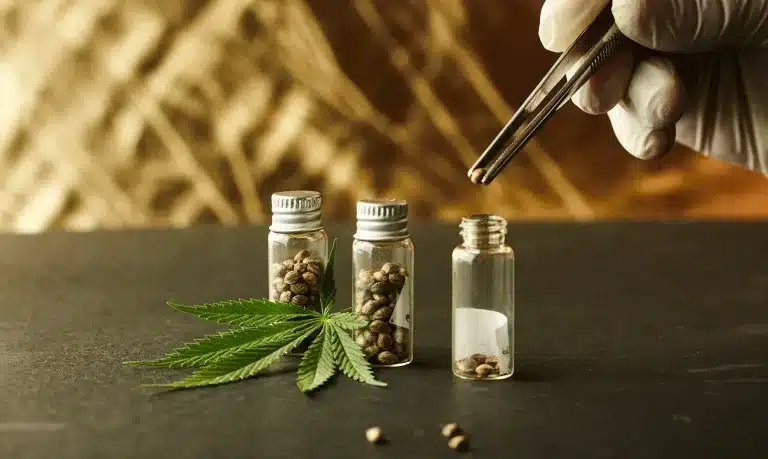- The Risks of Driving After Cannabis Use
- Medical Cannabis Versus Recreational Cannabis: Why It Matters
- Understanding Cannabis and Its Impact on Driving
- Factors that Influence Impairment
- How Long Should You Wait to Drive After Using Cannabis?
- Legal Implications of Driving Under the Influence of Cannabis
- Tips for Safe Cannabis Use and Driving
- Stay Safe on the Road: Cannabis and Driving Responsibly
As cannabis legalization continues to expand across the United States, it’s important for consumers to understand the potential risks associated with driving under the influence of it. While the effects of alcohol on driving are well-known, the relationship between cannabis use and road safety is more complex and less understood. That’s why our team at Windy City Cannabis put this article together — to explore the current research on cannabis-impaired driving, the factors that influence impairment, and guidelines for safe driving after consuming cannabis.
The Risks of Driving After Cannabis Use

Cannabis use can impair various cognitive and motor skills that are essential for safe driving, including reaction time, attention, perception, and coordination. Studies have shown that cannabis use can double the risk of being involved in a motor vehicle accident, particularly at higher doses.
According to the National Academies of Sciences, Engineering, and Medicine, there is substantial evidence that cannabis use impairs driving performance and increases the risk of crashes. The risk is especially high when cannabis is combined with alcohol or other drugs.
Medical Cannabis Versus Recreational Cannabis: Why It Matters
When discussing cannabis use and driving, it’s important to distinguish between medical cannabis and recreational cannabis. While both contain THC, the primary psychoactive compound in cannabis, there are some key differences:
|
Factor |
Medical Cannabis |
Recreational Cannabis |
| Purpose | Used to treat specific medical conditions under the guidance of a healthcare provider. | Used for recreational purposes, often without medical supervision. |
| Regulation | Subject to stricter regulations and quality control measures to ensure consistency and safety. | May be less regulated, with variable potency and purity. |
| Potency | Often available in a range of potencies and formulations to allow for personalized dosing. | Potency can vary widely between strains and products, making it harder to control dosage. |
| Consumption methods | May be consumed through various methods, including oral, sublingual, and topical administration, which can have different onset and duration of effects. | Often smoked or vaped, leading to rapid onset and shorter duration of effects. |
| Physician involvement | Use is overseen by a medical professional who can monitor for potential drug interactions and side effects. | Typically used without medical supervision, increasing the risk of adverse effects or interactions with other substances. |
While both medical cannabis and recreational “weed” can potentially impair driving, the risks may be more pronounced with recreational use due to the lack of medical supervision, variable potency, and more rapid onset of effects when smoked or vaped.
Understanding Cannabis and Its Impact on Driving
Cannabis contains hundreds of chemical compounds, including THC and CBD. THC is primarily responsible for the psychoactive effects of cannabis, while CBD is non-intoxicating and may have therapeutic benefits.
When cannabis is consumed, THC enters the bloodstream and can cross the blood-brain barrier, leading to a range of effects on the mind and body. These effects can vary widely depending on the individual, the potency of the cannabis, and the consumption method.
Impacts on Driving Performance
Cannabis use can impair several key skills and functions that are critical for safe driving:
|
Skill/Function |
Potential Impact of Cannabis Use |
| Reaction time | Slowed reaction time, which can delay braking or swerving in response to hazards. |
| Attention | Difficulty maintaining attention on the road, increased distractibility. |
| Perception | Altered perception of time and distance, difficulty judging gaps in traffic. |
| Coordination | Impaired hand-eye coordination and motor skills, which can affect steering and other driving maneuvers. |
| Decision-Making | Impaired judgment and decision-making abilities, which can lead to risky behaviors like speeding or ignoring traffic signals. |
| Memory | Short-term memory impairment, which can cause difficulties in remembering directions or recent events on the road. |
These impairments can be especially dangerous when driving, as they can reduce a driver’s ability to respond to changing road conditions, make safe decisions, and operate a vehicle effectively. The risk of impairment is highest in the hours immediately following cannabis use and can persist for several hours, depending on the factors discussed below.
Factors that Influence Impairment
The extent and duration of cannabis-related impairment can vary widely depending on several factors:
- Dosage: Higher doses of THC, the primary psychoactive compound in cannabis, are associated with greater impairment.
- Consumption method: The effects of smoking or vaping cannabis can be felt within minutes and typically peak within 30 minutes, while the effects of consuming edibles can be delayed by 1-3 hours and last longer.
- Individual differences: Factors such as tolerance, body weight, and metabolism can influence how quickly an individual processes and eliminates THC from their system.
- Cannabis potency: The THC content of cannabis products can vary widely, with some strains and concentrates containing much higher levels than others.
How Long Should You Wait to Drive After Using Cannabis?

The duration of cannabis-related impairment can be difficult to predict, as THC can remain detectable in the blood for hours or even days after use, long after the acute effects have worn off. However, most studies suggest that the majority of driving-related impairment subsides within 3-4 hours after smoking cannabis.
As a general guideline, the American Automobile Association (AAA) recommends waiting at least 4 hours after smoking cannabis before driving, and at least 6 hours if you have consumed edibles. However, these are rough estimates, and some experts recommend waiting even longer, particularly if you have consumed a high dose or have a low tolerance.
It’s important to note that these guidelines are based on averages, and individual impairment can vary widely. If you feel impaired or unsure of your ability to drive safely, it’s always best to err on the side of caution and find an alternative mode of transportation.
Legal Implications of Driving Under the Influence of Cannabis
Driving under the influence of cannabis is illegal in all 50 states, even in jurisdictions where recreational or medical use is permitted. However, the specific laws and penalties vary by state.
Some states, such as Colorado and Washington, have set legal limits for THC blood concentration, similar to the 0.08% BAC limit for alcohol. However, these laws are controversial, as there is no clear scientific consensus on what level of THC is consistently associated with impairment.
Other states, such as California, have a zero-tolerance policy for driving with any detectable amount of THC in the blood. In these states, you can be charged with a DUI even if you don’t feel impaired or exhibit signs of impairment.
Let’s have a look at some more states where cannabis usage is possible and the legalized dosage in blood while driving:
|
State |
Cannabis Usage Legalized |
DUI Threshold |
Notes |
|
California |
Yes | 5 ng/ml of THC | Zero tolerance for drivers under 21 and commercial drivers |
|
Colorado |
Yes | 5 ng/ml of THC |
Also includes impairment levels, regardless of THC concentration |
| Massachusetts |
Yes |
No specific threshold |
Relies on officer observation and chemical tests |
|
Michigan |
Yes | No specific threshold |
Zero tolerance for THC, relies on impairment evidence |
|
Nevada |
Yes | 2 ng/ml of THC |
Strict threshold compared to other states |
|
Oregon |
Yes | No specific threshold |
Uses officer observations and sobriety tests |
|
Washington |
Yes | 5 ng/ml of THC |
Includes impairment observations |
|
Alaska |
Yes | No specific threshold |
Focuses on impairment without a specific THC limit |
|
Illinois |
Yes | No specific threshold |
Law enforcement uses standard field sobriety tests |
|
Maine |
Yes | No specific threshold |
Enforcement based on impairment evidence |
|
Vermont |
Yes |
No specific threshold |
Officers trained to recognize impairment |
|
Arizona |
Yes |
Impairment to the slightest degree |
Zero tolerance policy toward THC presence |
|
New York |
Yes | No specific threshold |
Focuses on impairment, with trained Drug Recognition Experts (DRE) |
Regardless of the specific laws in your state, it’s important to remember that driving under the influence of cannabis is a serious offense that can result in fines, license suspension, and even jail time. It’s not worth risking your safety or the safety of others by getting behind the wheel while impaired.
Tips for Safe Cannabis Use and Driving
If you choose to use cannabis, there are several steps you can take to minimize the risks of impaired driving:
- Plan ahead: If you know you’ll be consuming cannabis, make arrangements for a designated driver, ride-sharing service, or public transportation ahead of time.
- Start low and go slow: If you’re new to cannabis or trying a new product, start with a low dose and wait at least a few hours before considering driving.
- Be aware of your limits: Pay attention to how cannabis affects you personally, and don’t drive if you feel even slightly impaired.
- Combine responsibly: Avoid mixing cannabis with alcohol or other drugs, as this can greatly increase impairment and the risk of accidents.
- Store safely: Keep cannabis products out of reach of drivers and secured while in a vehicle to avoid the temptation to consume while on the road.
Stay Safe on the Road: Cannabis and Driving Responsibly
Cannabis use can significantly impair the skills and judgment needed for safe driving, and the risks should not be underestimated. While more research is needed to fully understand the relationship between cannabis use and road safety, the current evidence suggests that it’s best to err on the side of caution and avoid driving for several hours after consuming cannabis.
By planning ahead, consuming responsibly, and being aware of the potential dangers, cannabis users can help keep themselves and others safe on the road. Remember, impaired driving puts not only your own life at risk but also the lives of passengers, other drivers, and pedestrians. Make the responsible choice and find a safe alternative to driving if you’ve consumed cannabis.
At Windy City Cannabis, we’re committed to providing our customers with not only high-quality products but also the information they need to consume cannabis safely and responsibly. We encourage all of our customers to educate themselves on the potential risks of cannabis use, including impaired driving, and to always prioritize their safety and the safety of others. If you have any questions or concerns about safe cannabis use, please don’t hesitate to reach out to our knowledgeable staff. We’re here to help you navigate the world of cannabis with confidence and care.
Sign Up for Our Rewards Program
Find your perfect cannabis products at Windy City Cannabis. Whether you’re a medical or recreational user, we’ve got you covered.




